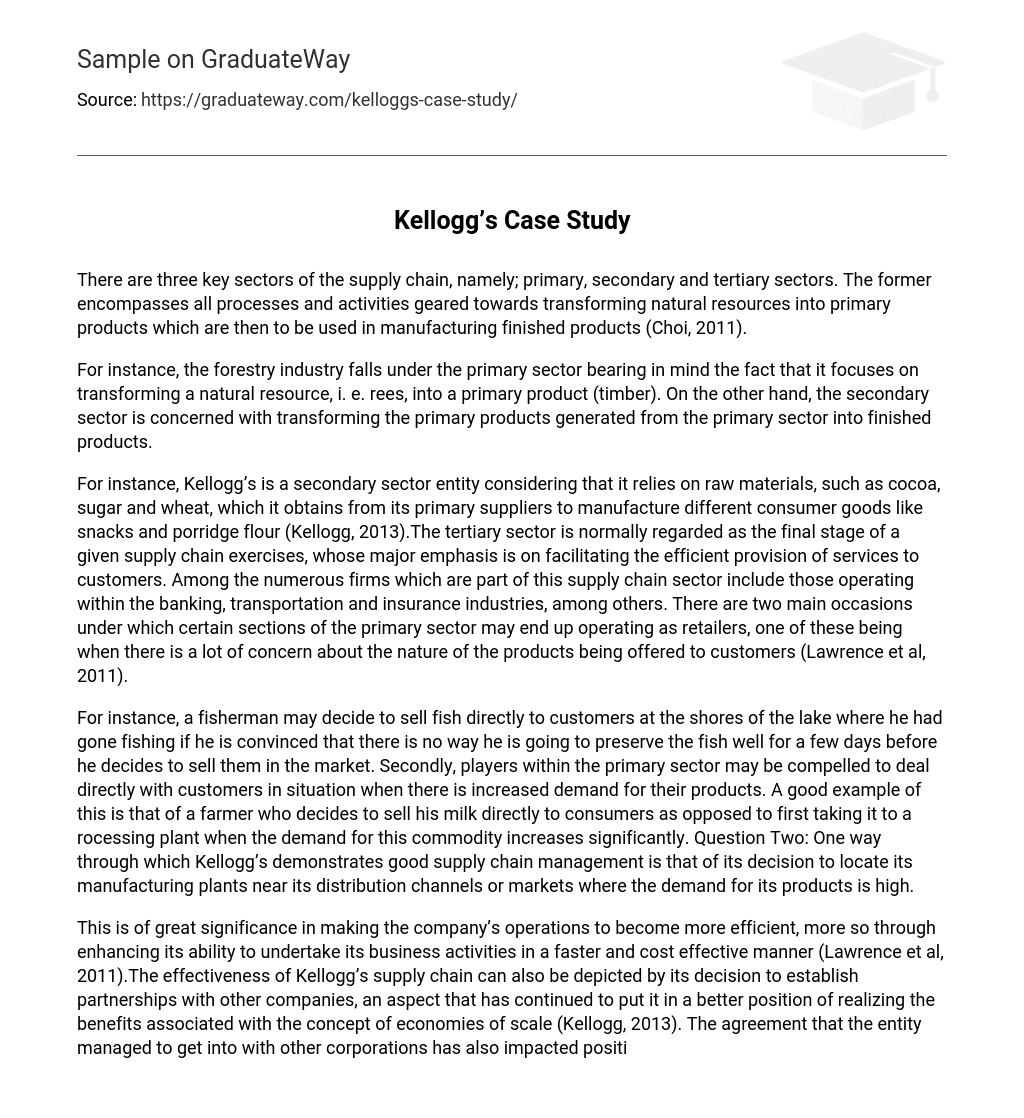Choi (2011) states that the supply chain is composed of three sectors: primary, secondary, and tertiary. The primary sector’s role is to transform natural resources into primary products utilized in the production of final goods.
The forestry industry is categorized under the primary sector as it involves converting natural resources, such as trees, into primary products like timber. On the other hand, the secondary sector concentrates on taking these primary products from the primary sector and transforming them into finished goods.
Kellogg’s relies on primary suppliers for ingredients such as cocoa, sugar, and wheat. These ingredients are used in the production of various consumer goods like snacks and porridge flour (Kellogg, 2013).
The tertiary sector is the final stage of the supply chain that focuses on providing efficient services to customers. This sector encompasses banking, transportation, insurance, and other industries.
At times, certain parts of the primary sector may also serve as retailers when there are concerns about customer access to products (Lawrence et al., 2011).
When fishermen are unable to store fish for a long time before selling them in the market, they might choose to sell them directly to customers at the lake shore. Likewise, individuals in the primary sector may feel obligated to sell their products directly to customers during periods of high demand. For example, if there is a substantial increase in milk demand, a farmer may opt to sell it directly to consumers rather than transporting it to a processing plant.
Kellogg’s showcases efficiency in supply chain management by strategically placing their manufacturing plants near distribution channels or markets with high product demand.
The company can improve its efficiency by enhancing its ability to conduct business faster and more cost-effectively, as demonstrated by Kellogg’s through partnerships with other companies. These collaborations enable the company to benefit from economies of scale and also contribute to reducing carbon emissions, ensuring regulatory compliance, and strengthening its corporate image. Kellogg’s is fully committed to efficiently delivering products to various markets, a crucial aspect of supply chain management (Lawrence et al., 2011; Kellogg, 2013).
Kellogg’s has opted to engage multiple intermediaries for the purpose of expanding its transportation and distribution channels. Nonetheless, the company should contemplate employing solar energy in lieu of fuel energy for its manufacturing operations. This shift would allow Kellogg’s to diminish its current elevated manufacturing expenses and foster eco-friendliness within its production procedures. Additionally, Kellogg’s maintains robust associations with businesses in the tertiary sector to guarantee favorable reception of its products by consumers.
This is an explanation as to why Kellogg’s entered into an agreement with Tesco. The collaboration between Kellogg’s and tertiary sector entities is part of their strategy to ensure successful business activities. For example, maintaining good relationships with banks allows Kellogg’s to acquire additional funds for operations or investments (Leeman, 2010). The decision by large manufacturers like Kellogg’s to outsource some activities to specialist companies like TDG has the major benefit of making their supply chain and distribution channels more efficient.
The achievement of this objective is usually facilitated through the emphasis of specialist entities employing computerized systems for stock handling and logistic functions. This enhances the timely and cost efficient delivery of stock in the larger manufacturers’ retail stores (Choi, 2011). Additionally, these specialists help larger firms like Kellogg’s minimize wastages in their supply chains by streamlining transportation, distribution, and storage systems (Leeman, 2010). For example, TDG enables Kellogg’s to avoid wastages during product transportation by ensuring optimal lorry capacity is observed.





